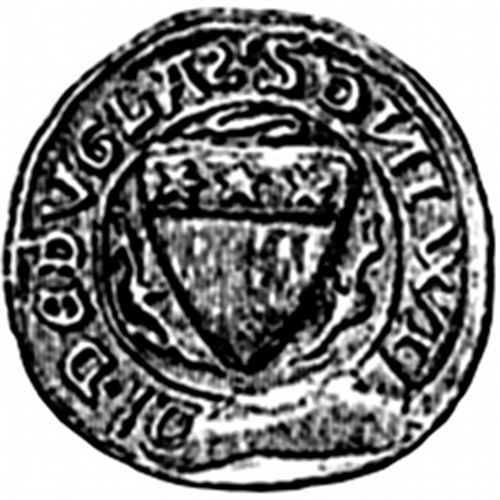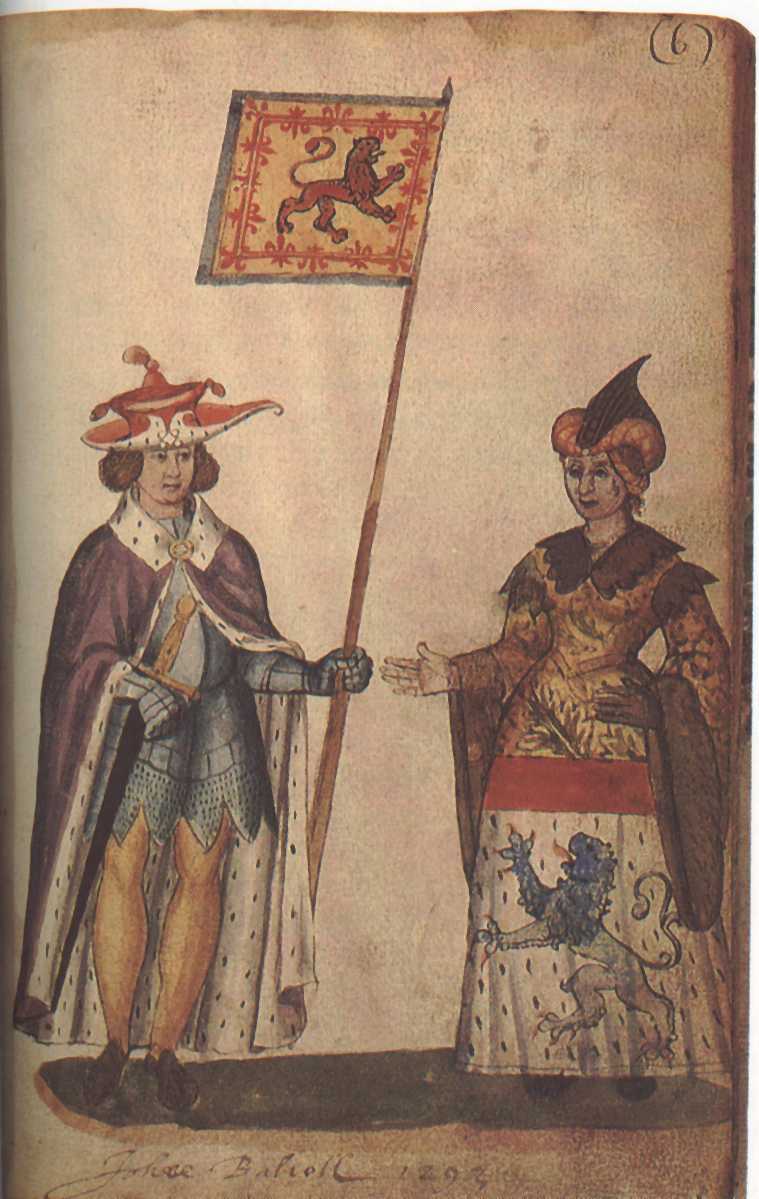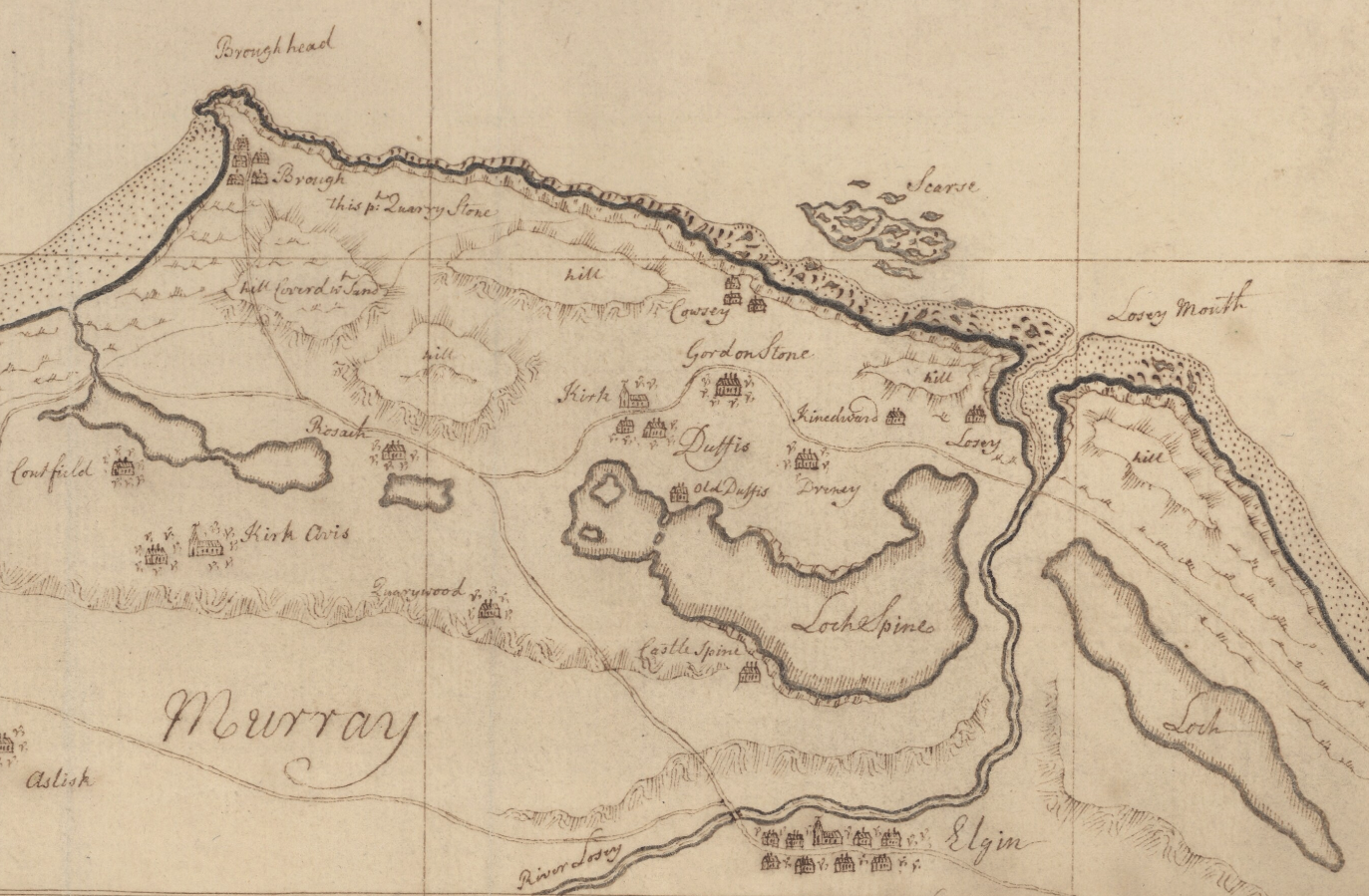|
Andrew De Moray
Andrew Moray (; ), also known as Andrew de Moray, Andrew of Moray, or Andrew Murray, was a Scots esquire, who rose to prominence during the First Scottish War of Independence. He initially raised a small band of supporters at Avoch Castle in early summer 1297 to fight King Edward I of England and had soon successfully regained control of the north for the absent Scots king, John Balliol. Moray subsequently merged his army with that of William Wallace, and on 11 September 1297 jointly led the combined army to victory at the Battle of Stirling Bridge. He was severely wounded in the course of the battle, dying at an unknown date and place that year. Childhood Andrew Moray the younger of Petty was born late in the second half of the 13th century. The date and place of his birth are unknown. Andrew's father was Sir Andrew Moray of Petty, an influential north Scotland baron and Justiciar of Scotia (1289?–1296), and his mother was the historically anonymous fourth daughter of ... [...More Info...] [...Related Items...] OR: [Wikipedia] [Google] [Baidu] |
Scotland
Scotland is a Countries of the United Kingdom, country that is part of the United Kingdom. It contains nearly one-third of the United Kingdom's land area, consisting of the northern part of the island of Great Britain and more than 790 adjacent Islands of Scotland, islands, principally in the archipelagos of the Hebrides and the Northern Isles. To the south-east, Scotland has its Anglo-Scottish border, only land border, which is long and shared with England; the country is surrounded by the Atlantic Ocean to the north and west, the North Sea to the north-east and east, and the Irish Sea to the south. The population in 2022 was 5,439,842. Edinburgh is the capital and Glasgow is the most populous of the cities of Scotland. The Kingdom of Scotland emerged as an independent sovereign state in the 9th century. In 1603, James VI succeeded to the thrones of Kingdom of England, England and Kingdom of Ireland, Ireland, forming a personal union of the Union of the Crowns, three kingdo ... [...More Info...] [...Related Items...] OR: [Wikipedia] [Google] [Baidu] |
Moray
Moray ( ; or ) is one of the 32 council areas of Scotland. It lies in the north-east of the country, with a coastline on the Moray Firth, and borders the council areas of Aberdeenshire and Highland. Its council is based in Elgin, the area's largest town. The main towns are generally in the north of the area on the coastal plain. The south of the area is more sparsely populated and mountainous, including part of the Cairngorms National Park. The council area is named after the historic county of Moray (called Elginshire prior to 1919), which was in turn named after the medieval Province of Moray, each of which covered different areas to the modern council area. The modern area of Moray was created in 1975 as a lower-tier district within the Grampian Region. The Moray district became a single-tier council area in 1996. History The name, first attested around 970 as ', and in Latinised form by 1124 as ', derives from the earlier Celtic forms *''mori'' 'sea' and *''treb'' ... [...More Info...] [...Related Items...] OR: [Wikipedia] [Google] [Baidu] |
Moray Firth
The Moray Firth (; , or ) is a roughly triangular inlet (or firth) of the North Sea, north and east of Inverness, which is in the Highland council area of the north of Scotland. It is the largest firth in Scotland, stretching from Duncansby Head (near John o' Groats) in the north, in the Highland council area, and Fraserburgh in the east, in the Aberdeenshire council area, to Inverness and the Beauly Firth in the west. Therefore, three council areas have Moray Firth coastline: Highland to the west and north of the Moray Firth and Highland, Moray and Aberdeenshire to the south. The firth has more than of coastline, much of which is cliff. Etymology The firth is named after the 10th-century Province of Moray, whose name in turn is believed to derive from the sea of the firth itself. The local names ''Murar'' or ''Morar'' are suggested to derive from , the Gaelic for sea, whilst ''Murav'' and ''Morav'' are believed to be rooted in Celtic words (sea) and (side), co ... [...More Info...] [...Related Items...] OR: [Wikipedia] [Google] [Baidu] |
Clan Douglas
Clan Douglas ( Gaelic: ''Dùbhghlas'') is an ancient clan or noble house from the Scottish Lowlands. Taking their name from Douglas in Lanarkshire, their leaders gained vast territories throughout the Borders, Angus, Lothian, Moray, and also in France and Sweden. The family is one of the most ennobled in the United Kingdom and has held numerous titles. The Douglases were one of Scotland's most powerful families,Way, George and Squire, Romily. (1994). ''Collins Scottish Clan & Family Encyclopedia''. (Foreword by The Rt Hon. The Earl of Elgin KT, Convenor, The Standing Council of Scottish Chiefs). pp. 384–385. and certainly the most prominent family in lowland Scotland during the Late Middle Ages, often holding the real power behind the throne of the Stewart kings. The heads of the House of Douglas held the titles of the Earl of Douglas (Black Douglas) and later the Earl of Angus (Red Douglas). The clan does not currently have a chief recognised by the Lord Lyon. The princ ... [...More Info...] [...Related Items...] OR: [Wikipedia] [Google] [Baidu] |
Clan Cumming
Clan Cumming ( ), historically known as Clan Comyn, is a Scottish clan from the central Scottish Highlands, Highlands that played a major role in the history of 13th-century Scotland and in the Wars of Scottish Independence. The Clan Comyn was once the most powerful family in 13th-century Scotland, until they were defeated in civil war by their rival to the Scottish throne, Robert the Bruce. History Origin of the clan Like many of the families that came to power under King David I of Scotland, David I of Scotland, the Comyn clan is of Normans, Norman or Flanders, Flemish origin. The Comyn (surname), surname may be a place-name, possibly derived from Bosc-Bénard-Commin, near Rouen in the Duchy of Normandy, or from Comines, Nord, Comines, near Lille, in France. Richard Comyn, the nephew of William Cumin, William Comyn, chancellor to King David, is the one who established this family in Scotland. His son was William Comyn, Lord of Badenoch, William Comyn, who married Marjory, Co ... [...More Info...] [...Related Items...] OR: [Wikipedia] [Google] [Baidu] |
Alexander III Of Scotland
Alexander III (; Modern Gaelic: ; 4 September 1241 – 19 March 1286) was King of Alba (Scotland) from 1249 until his death. He concluded the Treaty of Perth, by which Scotland acquired sovereignty over the Western Isles and the Isle of Man. His heir, Margaret, Maid of Norway, died before she could be crowned. Life Alexander was born at Roxburgh, the only son of Alexander II by his second wife Marie de Coucy. Alexander's father died on 6 July 1249 and he became king at the age of seven, inaugurated at Scone on 13 July 1249. The years of his minority featured an embittered struggle for the control of affairs between two rival parties, the one led by Walter Comyn, Earl of Menteith, the other by Alan Durward, Justiciar of Scotia. The former dominated the early years of Alexander's reign. At the marriage of Alexander to Margaret of England in 1251, Henry III of England seized the opportunity to demand homage from his son-in-law for the Scottish kingdom, but Alexander di ... [...More Info...] [...Related Items...] OR: [Wikipedia] [Google] [Baidu] |
List Of Scottish Monarchs
The monarch of Scotland was the head of state of the Kingdom of Scotland. According to tradition, Kenneth I MacAlpin () was the founder and first King of the Kingdom of Scotland (although he never held the title historically, being King of the Picts instead). The List of kings of the Picts, Kingdom of the Picts just became known as the Kingdom of Alba in Scottish Gaelic, which later became known in Scots language, Scots and English as ''Scotland''; the terms are retained in both languages to this day. By the late 11th century at the very latest, Scottish kings were using the term , or King of Scots, to refer to themselves in Latin. The Kingdom of Scotland was merged with the Kingdom of England to form a single Kingdom of Great Britain in 1707. Thus, Anne, Queen of Great Britain, Queen Anne became the last monarch of the ancient kingdoms of Scotland and England and the first of Great Britain, although the kingdoms had shared a monarch since 1603 (see Union of the Crowns). Her un ... [...More Info...] [...Related Items...] OR: [Wikipedia] [Google] [Baidu] |
Loch Spynie
Loch Spynie is a small loch located between the towns of Elgin and Lossiemouth in Moray, Scotland. Close to Spynie Palace, the ancient home of the bishops of Moray, it is an important wildlife habitat which is protected as a Ramsar Site. History Loch Spynie is a remnant of a great wetland that stretched from the western shore of the current loch to the mouth of the River Lossie and, at that time, many of the settlements along the Moray coast were actually islands in the Moray Firth. The connections this area had to the sea silted up over the centuries but the loch was still navigable to the sea in the middle ages. In the mid-19th century the Spynie Canal was constructed by Thomas Telford to drain the loch for farmland. Artificial shores were built on the western and northern sides of the loch which were kept for wildfowling and fishing. Wildfowling has stopped altogether since 1981 and the amount of angling has been negligible since that year too. In 1679 Janet Grant was convi ... [...More Info...] [...Related Items...] OR: [Wikipedia] [Google] [Baidu] |
Duffus Castle
Duffus Castle, near Elgin, Moray, Scotland, was a motte-and-bailey castle and was in use from c. 1140 to 1705. During its occupation it underwent many alterations. The most fundamental was the destruction of the original wooden structure and its replacement with one of stone. At the time of its establishment, it was one of the most secure fortifications in Scotland. At the death of the 2nd Lord Duffus in 1705, the castle had become totally unsuitable as a dwelling and so was abandoned. The wooden castle Oengus, Mormaer of Moray, led a rebellion against David I, King of Scots in 1130. After Oengus' defeat and death in battle, David installed Freskin, a nobleman probably of Flemish origin, as his chief agent in Moray, and he was probably the first to build a castle at Duffus. Freskin’s background is uncertain. The consensus amongst historians is that he was of Flemish background, the principal argument being that "Freskin" is a Flemish name. Undoubtedly, King David, himse ... [...More Info...] [...Related Items...] OR: [Wikipedia] [Google] [Baidu] |
Motte-and-bailey
A motte-and-bailey castle is a European fortification with a wooden or stone keep situated on a raised area of ground called a motte, accompanied by a walled courtyard, or bailey, surrounded by a protective ditch and palisade. Relatively easy to build with unskilled labour, but still militarily formidable, these castles were built across northern Europe from the 10th century onwards, spreading from Normandy and Anjou in France, into the Holy Roman Empire, as well as the Low Countries it controlled, in the 11th century, when these castles were popularized in the area that became the Netherlands. The Normans introduced the design into England and Wales. Motte-and-bailey castles were adopted in Scotland, Ireland, and Denmark in the 12th and 13th centuries. By the end of the 13th century, the design was largely superseded by alternative forms of fortification, but the earthworks remain a prominent feature in many countries. Architecture Structures A motte-and-bailey castle wa ... [...More Info...] [...Related Items...] OR: [Wikipedia] [Google] [Baidu] |
David I Of Scotland
David I or Dauíd mac Maíl Choluim (Scottish Gaelic, Modern Gaelic: ''Daibhidh I mac [Mhaoil] Chaluim''; – 24 May 1153) was a 12th century ruler and saint who was David I as Prince of the Cumbrians, Prince of the Cumbrians from 1113 to 1124 and King of Scotland from 1124 to 1153. The youngest son of King Malcolm III and Saint Margaret of Scotland, Queen Margaret, David spent most of his childhood in Scotland but was exiled to Kingdom of England, England temporarily in 1093. Perhaps after 1100, he became a dependent at the court of King Henry I of England, by whom he was influenced. When David's brother Alexander I of Scotland, Alexander I died in 1124, David chose, with the backing of Henry I, to take the Kingdom of Alba (Scotland) for himself. He was forced to engage in warfare against his rival and nephew, Máel Coluim mac Alaxandair. Subduing the latter seems to have taken David ten years, a struggle that involved the destruction of Óengus of Moray, Óengus, Mormaer of ... [...More Info...] [...Related Items...] OR: [Wikipedia] [Google] [Baidu] |
Laich Of Moray
 The Laich of Moray or Laigh of Moray (locally: Laich o' Moray) () is the rich agricultural coastal plain in Moray. ''Laich'' is a Scots language, Scots word meaning Low-lying land. The generally accepted area covered by the term ''Laich of Moray'' is from Fochabers to Brodie and also includes the towns of Elgin, Moray, Elgin, Forres, Lossiemouth, Burghead, Hopeman and Lhanbryde.
Landforms of Moray
Plains of the United Kingdom
{{Moray-geo-stub ...
The Laich of Moray or Laigh of Moray (locally: Laich o' Moray) () is the rich agricultural coastal plain in Moray. ''Laich'' is a Scots language, Scots word meaning Low-lying land. The generally accepted area covered by the term ''Laich of Moray'' is from Fochabers to Brodie and also includes the towns of Elgin, Moray, Elgin, Forres, Lossiemouth, Burghead, Hopeman and Lhanbryde.
Landforms of Moray
Plains of the United Kingdom
{{Moray-geo-stub ...
[...More Info...] [...Related Items...] OR: [Wikipedia] [Google] [Baidu] |








